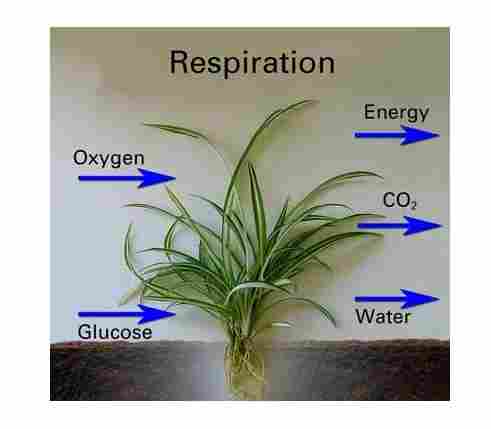Respiration in Plants Goyal Brother Solutions ICSE Class-9 Biology Ch-7. We Provide Solutions of Exercise-7 Respiration in Plants Goyal Brother Prakashan ICSE Class-9 Ch-7.

The solution contain All Type exercise question such as name the following, odd one, MCQs and figure based. Visit official Website CISCE for detail information about ICSE Board Class-9.
Ch-7 Respiration in Plants Goyal Brother Solutions ICSE Class-9
| Board | ICSE |
| Publications | Goyal Brother Prakashan |
| Subject | Biology |
| Class | 9th |
| Writer | Dr. S.K. Aggarwal |
| Chapter-7 | Respiration in Plants |
| Topics | Solutions of Exercises-7 |
| Edition | for 2022-2023 Academic Session |
ICSE Class-9 Biology Ch-7 Respiration in Plants Goyal Brother Prakashan Solutions
(Page-73)
Questions 1. Complete the following statements by choosing the correct alternative out of those given within brackets:
(i) During respiration, temperature …………….. (rises considerably/remains low/does not change)
(ii) Respiration is controlled by …………….. (enzyme/catalyst/heat)
(iii) Respiration is a …………….. process. (physical/chemical/
Answer :
(i) rises considerably
(ii) enzyme
(iii) biochemical
Questions 2. Mark True (T) or False (F) against the following statements:
(i) Anaerobic respiration requires oxygen. F
(ii) Combustion is an enzymatic process. T
(iii) Respiration is a biochemical process. T
(iv) All food materials are converted into glucose, before they are used as a source of energy. T
(v) Pneumatophores are characteristic of mangrove plants. T
(vi) Respiration occurs only in presence of light. F
Questions 3. Find the odd one out and give a reason for your answer :
(a) Glycolysis, pyruvic acid, carbon dioxide, glucose
(b) Anaerobic, oxygen, fermentation, alcohol.
Answer :
(a) pyruvic acid
(b) oxygen
Questions 4. Match the items in Column A with those in Column B:
| Column A | Column B |
| (a) Anaerobic respiration | (i) Krebs cycle |
| (b) Energy currency | (ii) Alcoholic fermentation |
| (c) Glycolysis | (iii) ATP |
| (d) Mitochondria | (iv) Cytoplasm |
Answer :
| Column A | Column B |
| (a) Anaerobic respiration | Alcoholic fermentation |
| (b) Energy currency | ATP |
| (c) Glycolysis | (iii) Krebs cycle |
| (d) Mitochondria | (iv) Cytoplasm |
Questions 5. Define respiration.
Answer : a process in living organisms involving the production of energy, typically with the intake of oxygen and the release of carbon dioxide from the oxidation of complex organic substances.
Questions 6. List any two activities for which the energy released during respiration is used.
Answer : The energy produced during respiration is used in many different ways, some examples of what it is used for are: Working your muscles. Growth and repair of cells. Building larger molecules from smaller ones i.e. proteins from amino acids.
Questions 7. List the differences between aerobic respiration and anaerobic respiration.
Answer :
| Aerobic Respiration | Anaerobic Respiration |
|---|---|
| It can be found in the cytoplasm and the mitochondria. | It can be found only in the cytoplasm. |
| Glucose breaks down into carbon dioxide and water. | Glucose breaks down into ethyl alcohol, carbon dioxide and energy. |
Questions 8. Give an example each of organisms in which alcoholic fermentation and lactic acid formation Occurs.
Answer : lactic acid fermentation occurs in human being muscles .and alcoholic fermentation occurs in yeast
Questions 9. Why is the energy released during anaerobic respiration much less than the energy released during aerobic respiration?
Answer : Aerobic respiration is the complete breakdown of glucose in the presence of oxygen. So, it produces more energy. On the other hand, anaerobic respiration is the incomplete breakdown of glucose in the absence of oxygen. So, it produces less energy.
Questions 10. List the end products formed in aerobic respiration and anaerobic respiration.
Answer : Carbon dioxide and water are the end products of aerobic respiration, while alcohol is the end product of anaerobic respiration. Aerobic respiration releases more energy than anaerobic respiration.
Questions 11. Give the overall chemical equations that shows
(i) aerobic respiration, and
(ii) anaerobic respiration in plants.
Answer :
(i) C6H12O6 + 6O2 yields 6CO2 + 6H2O + energy (as ATP).
(ii) C6H12O6→2C2H5OH+2CO2+energy
Questions 12. What are the two stages of respiration in aerobes?
Answer : The different stages of aerobic respiration are: Glycolysis. Formation of acetyl coenzyme A. Citric acid cycle
Questions 13. Which part of respiration is common to both aerobes and anaerobes? Where does it occur inside the cell?
Answer : The glycolysis pathway is common for both aerobes and anaerobes. In this process, glucose breaks down to form pyruvate in the cytoplasm of the cell.
Questions 14. What is glycolysis? Give a brief of this process.
Answer : Glycolysis is the process in which glucose is broken down to produce energy. It produces two molecules of pyruvate, ATP, NADH and water. The process takes place in the cytoplasm of a cell and does not require oxygen. It occurs in both aerobic and anaerobic organisms.
Questions 15. Write in brief about Krebs cycle.
Answer : The Krebs cycle starts with pyruvic acid from glycolysis.Each small circle in the diagram represents one carbon atom. For example, citric acid is a six carbon molecule, and OAA (oxaloacetate) is a four carbon molecule. Follow what happens to the ca rbon atoms as the cycle proceeds.
Questions 16. What are lenticels? Where do they occur? Mention their role.
Answer : A lenticel is a porous tissue made up of vast intercellular gaps between cells. On stems and roots, lenticels appear as elevated circular, oval, or elongated patches. Lenticels allow gases to pass between the atmosphere and the organs’ interior tissues.
Questions 17. What are the means of gaseous exchange in plants?
Answer : In leaves and stem, exchange of gases takes place through stomata (guarded pores). 2. In stems with bark, exchange of gases take place through the lenticels.
Questions 18. Describe how you would show that a green plant respires.
Answer : Plants do breathe – they give out carbon dioxide and absorb oxygen from the air that surrounds them. Remember that a green plant respires all the time, day and night. A green plant photosynthesizes only in the presence of sunlight. All parts of the plant respire, the leaves, the stem, the roots and even the flowers.
Questions 19. Given below are two reactions.
(a) C6H12O6+ 6O2 ——> 6CO2 + 6H2O + Energy
(b) C6H12O6 —-> 2C2H5OH + Energy
Now, answer the following questions
(i) What processes are taking place in reactions (a) and (b)?
(ii) Where do these reactions take place? Name the organisms involved.
(iii) Mention three differences between the two reactions.
Answer :
(i) (a) AEROBIC RESPIRATION (b) ANAEROBIC RESPIRATION
(ii) mitochondria , AEROBIC RESPIRATION in higher animal while ANAEROBIC RESPIRATION in bacteria
(iii)
| Aerobic respiration | Anaerobic respiration |
|---|---|
| (i) It takes place in the presence of oxygen. | (i) It takes place in the absence of oxygen. |
| (ii) It produces a considerable amount of energy. | (ii) Lesser energy is produced during this process. |
|
Aerobic Respiration |
Anaerobic Respiration |
|
Oxygen is required for this type of respiration to take place. |
No requirement of oxygen in this process. |
|
It involves the exchange of gases between the organism and the outside environment. |
Exchange of gases is there but oxygen gas does not take part. |
|
Process of respiration takes place in the cytoplasm and the mitochondria. |
Takes place in the cytoplasm only. |
–: End of Pollination and Fertilisation Goyal Brother Solutions ICSE Class-9 Biology :–
Return to:- ICSE Biology for Class 9 Goyal Brothers Prakashan solutions
thanks


